
A transmission tower is a tall structure, usually a lattice tower made of steel that is used to support an overhead power line. In electrical grids, transmission towers carry high-voltage transmission lines that transport bulk electric power from generating stations to electrical substations, from which electricity is delivered to end consumers; moreover, utility poles are used to support lower-voltage sub-transmission and distribution lines that transport electricity from substations to electricity customers.

The Baltic Cable is a monopolar HVDC power line running beneath the Baltic Sea that interconnects the electric power grids of Germany and Sweden. Its maximum transmission power is 600 megawatts (MW).

The Pylons of Messina are two free-standing steel towers, the Sicilian one in Torre Faro and the Calabrian one in Villa San Giovanni. They were used from 1955 to 1994 to carry a 220 kilovolt power line across the Strait of Messina, between the Scilla substation in Calabria on the Italian mainland at 38°14′42″N15°40′59″E and the Messina-Santo substation in Sicily at 38°15′57″N15°39′04″E.
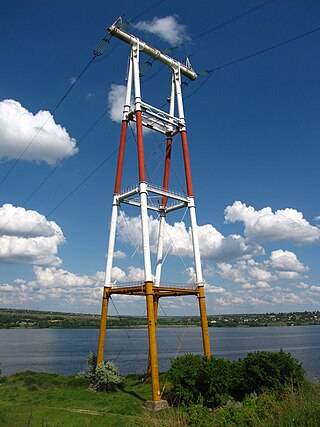
An overhead line crossing is the crossing of an obstacle—such as a traffic route, a river, a valley or a strait—by an overhead power line. The style of crossing depends on the local conditions and regulations at the time the power line is constructed. Overhead line crossings can sometimes require extensive construction and can also have operational issues. In such cases, those in charge of construction should consider whether a crossing of the obstacle would be better accomplished by an underground or submarine cable.
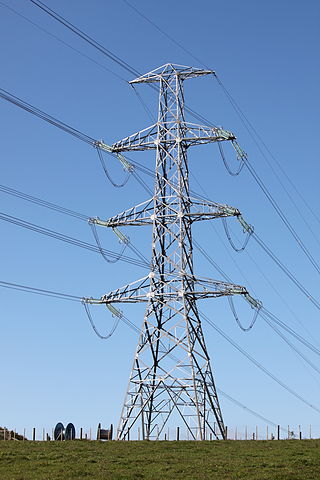
A dead-end tower is a fully self-supporting structure used in construction of overhead power lines. A dead-end transmission tower uses horizontal strain insulators at the end of conductors. Dead-end towers may be used at a substation as a transition to a "slack span" entering the equipment, when the circuit changes to a buried cable, when a transmission line changes direction by more than a few degrees, or at intervals along a straight run to limit the extent of a catastrophic collapse.

An overhead power line is a structure used in electric power transmission and distribution to transmit electrical energy along large distances. It consists of one or more conductors suspended by towers or poles. Since the surrounding air provides good cooling, insulation along long passages and allows optical inspection, overhead power lines are generally the lowest-cost method of power transmission for large quantities of electric energy.
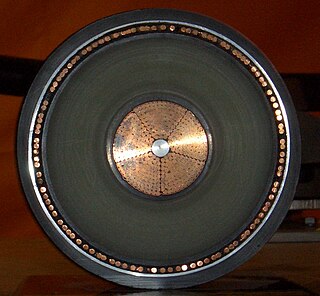
The Berlin 380 kV electric line is a 38.3-km double-circuit high-voltage electric three-phase power line in Berlin. An unusual system for a municipality, it was installed by the West Berlin Bewag utility company during the division of the city. Since 1951, West Berlin had been cut off from the East Berlin and East German power networks, and maintained an independent power generation capacity that was not connected to any other power grid. Berlin was connected to the western European power grid in 1994, following German reunification, by extending the 380 kV line.
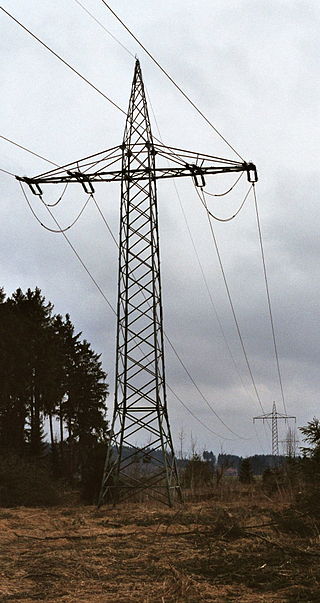
A traction network or traction power network is an electricity grid for the supply of electrified rail networks. The installation of a separate traction network generally is done only if the railway in question uses alternating current (AC) with a frequency lower than that of the national grid, such as in Germany, Austria and Switzerland.
The Yangtze River power line crossings are overhead power lines that cross the Yangtze River in China. There are at least three power line crossings on the Yangtze River at Jiangyin, Nanjing, and Wuhu. The towers of the crossing in Jiangyin are among the highest in the world.
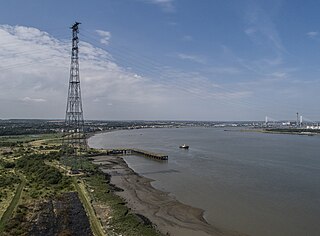
The 400 kV Thames Crossing is an overhead power line crossing of the River Thames, between Botany Marshes in Swanscombe, Kent, and West Thurrock, Essex, England. Its towers are the tallest electricity pylons in the UK.

Aust Severn Powerline Crossing is the longest overhead power line span in the United Kingdom with a length of 1,618 m (5,308 ft).

GKK Etzenricht, an abbreviation of Gleichstromkurzkupplung Etzenricht, meaning Etzenricht HVDC-back-to-back station, was an HVDC back-to-back facility near Etzenricht in the district of Neustadt an der Waldnaab in Bavaria, Germany. It was built on the site of the Etzenricht substation, a 380 kV/220 kV/110 kV-substation, which went into service in 1970 and expanded afterwards several times. The facility was used between 1993 and 1995 for the exchange of power between Germany and the Czech Republic, operated by Bayernwerk AG.

The 275 kV Forth Crossing is an overhead power line crossing of the River Forth in Scotland. The crossing, located next to the Clackmannanshire Bridge and the Kincardine Bridge, has the tallest electricity towers (pylons) in Scotland.
The Saint Lawrence River HVDC Powerline Crossing is the crossing of Hydro-Québec's Quebec-New England HVDC transmission line over the Saint Lawrence River between Grondines and Lotbinière, Quebec, Canada. The crossing is remarkable, for being first implemented as an overhead crossing, and then later replaced by a cable tunnel. Hydro-Québec wanted to complete the transmission line in time, which was only possible with an overhead crossing of Saint Lawrence River. However, due to the negative visual impact of the large towers of the overhead crossing on the local populations of Grondines and Lotbinière, it was decided to build a cable tunnel under the river, although this made the project more expensive.

The Whakamaru to Brownhill Road transmission line is a double-circuit 400 kV-capable transmission line constructed by Transpower to increase the capacity of the National Grid between the southern Waikato and the city of Auckland. The line runs from the Whakamaru sub-station near the Whakamaru Power Station, over a distance of 186 kilometres (116 mi) to the new Brownhill Road substation near Whitford in southeastern Auckland. The line will initially be operated at 220 kV. From Brownhill Road, 220 kV underground cables connect the line to the Pakuranga sub-station in eastern Auckland. The project was the subject of considerable controversy and protest during the planning and approval stages. Construction of the line started in February 2010, and the line was commissioned on 30 October 2012. The transmission line forms the major part of a wider North Island Grid Upgrade project with a forecast cost to completion of $894 million.
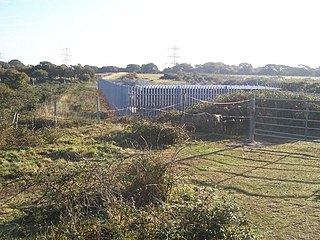
Fawley Tunnel, or Fawley transmission tunnel, is a 3-metre (9.8 ft) diameter, 2-mile (3.2 km) long tunnel under Southampton Water between Fawley Power Station and Chilling near Warsash. It carries the cables of two 400kV circuits of the National Grid.
The Thames Cable Tunnel, also known as the Tilbury – Gravesend Cable Tunnel, is a tunnel carrying high-voltage electrical transmission lines beneath the lower River Thames between Tilbury and Gravesend. It remains the furthest tunnel downstream on the Thames.
The Lower Lea Valley Cable Tunnels, known as the PLUG Project during construction, are a pair of 6 km cable tunnels running beneath the lower Lea Valley in east London. Constructed at a cost of £130m ahead of the 2012 London Olympic Games, they are owned by National Grid plc and UK Power Networks.
The River Medway Cable Tunnels are a pair of tunnels carrying high-voltage electricity transmission lines beneath the lower River Medway between the Isle of Grain and Chetney Marshes, Kent.
The Severn-Wye Cable Tunnel, also known as the Severn Cable Tunnel, carries high-voltage electricity transmission lines beneath the estuaries of the River Severn and River Wye between Newhouse (Mathern), Monmouthshire and Aust, South Gloucestershire.














